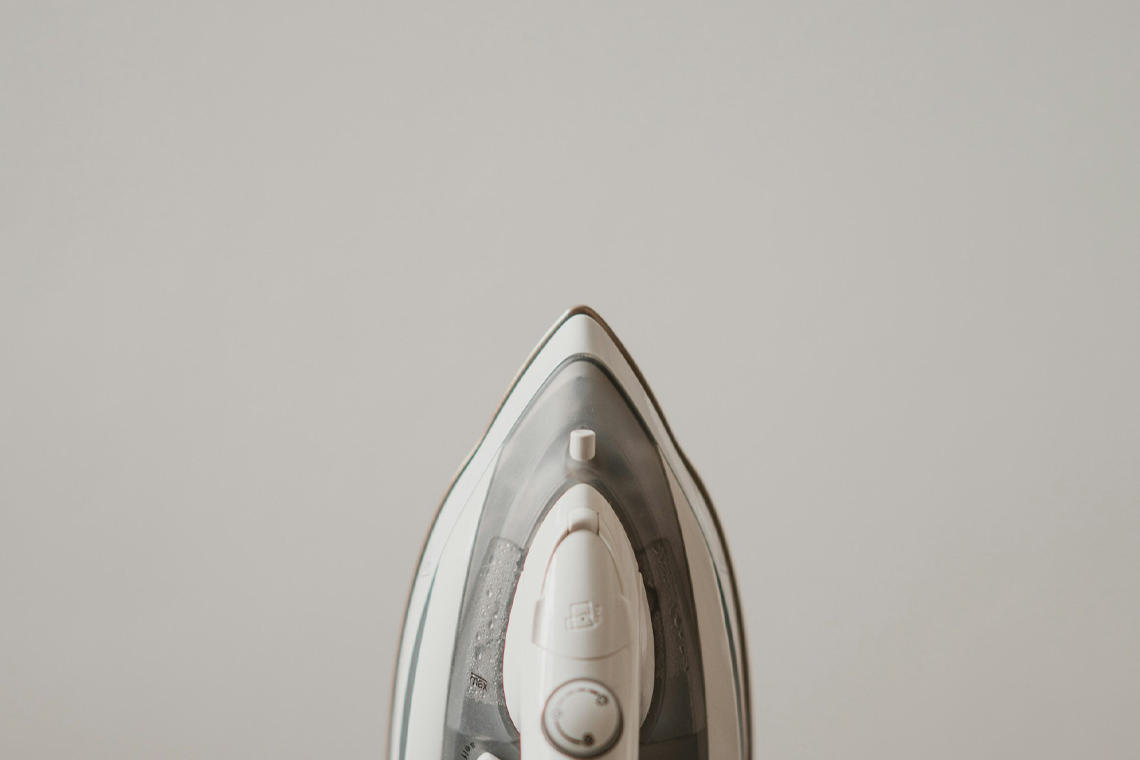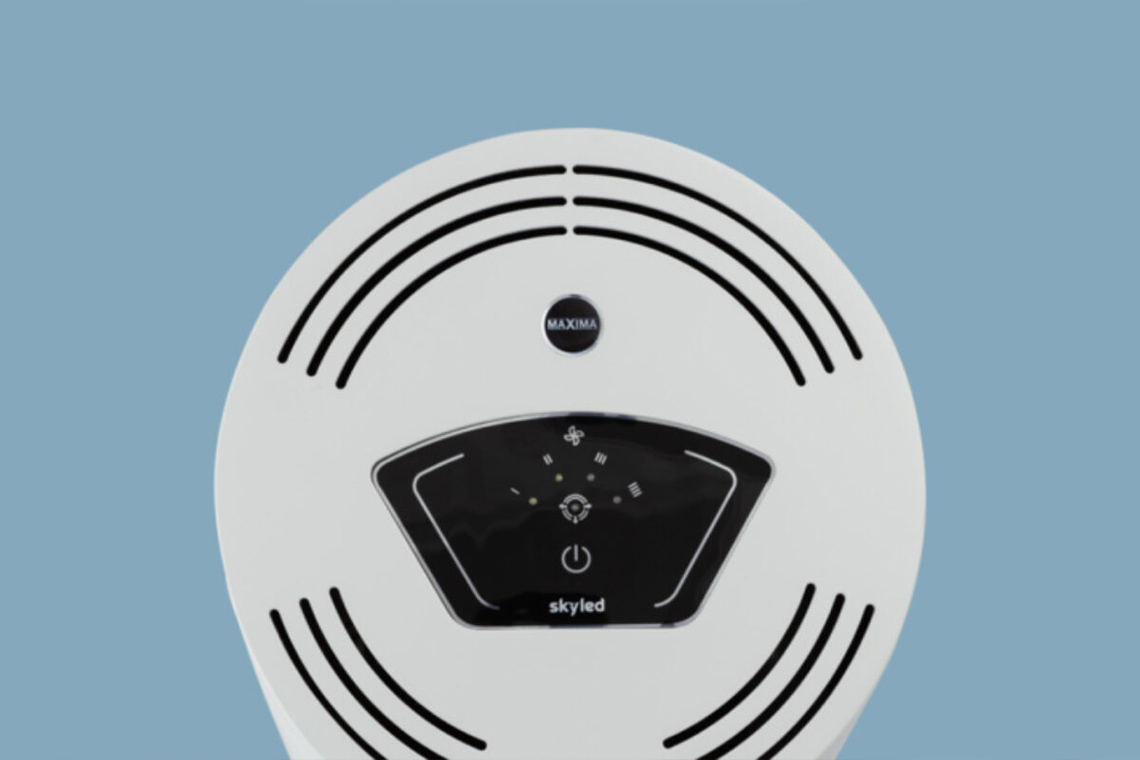18.01.2024
Steam iron: history and benefits

The steam iron stands as one of the most significant innovations in the field of fabric care. Its origins can be traced back to ancient China, where people used small copper pots heated with coals to press fabrics. Over the centuries, these techniques evolved into the invention of the first electric iron in 1891, followed by the steam iron in 1926.
Today, this innovation has become an essential tool in every house, blending convenience and efficiency. Steam irons offer a notable advantage: they can swiftly and effectively smooth fabrics compared to traditional methods. This efficiency is achieved through the power of steam, which penetrates fabric fibers, making ironing a breeze. Moreover, the sanitizing properties of steam help eliminate germs and bacteria from fabrics, ensuring they are not only wrinkle-free but also safe to wear.
What should you look for in a high-quality steam iron?
When selecting a steam iron, several essential features should be taken into account. Firstly, consider the iron’s power, measured in Watts, as it significantly impacts its performance. For effective domestic use, it is advisable to opt for a model with a power rating of at least 2000 watts. Additionally, the water tank’s capacity plays a vital role, especially when dealing with substantial amounts of laundry. A larger tank reduces the need for frequent refilling.
Another critical aspect is the quality of the soleplate. Different materials, such as steel, aluminum, Teflon, or ceramic, offer varying ironing experiences, suitable for different fabric types. Soleplate quality becomes even more crucial in a professional context. Typically, a special aluminum alloy is utilized to maintain a uniform temperature across the entire soleplate, preventing uneven heating. The internal structure that manages steam flow through the soleplate’s holes, often referred to as the “labyrinth”, is equally important. A well-designed labyrinth enhances ironing efficiency.
Additional features like automatic shut-off functionality and temperature control enhance convenience and safety during use. These features, materials, and options are indispensable components of a high-quality steam iron.
What is the cost of a steam iron?
When it comes to purchasing a steam iron, the price can vary considerably based on factors such as the brand, model, and included features. Typically, basic models start at around €30, while high-end steam irons with advanced features and external boilers can exceed €800. It is important to note that a higher price often correlates with increased durability and enhanced performance, making it a worthwhile investment, particularly if you have a substantial amount of laundry to iron. Ultimately, the cost of a steam iron is determined by your specific requirements and budget.
Why choose MAXIMA’s steam irons?
MAXIMA offers a range of steam irons designed to meet every need. When you choose MAXIMA’s steam irons, you are selecting a product that combines quality, efficiency, and innovation. Our models are equipped with high-quality soleplates to ensure smooth and uniform ironing on all types of fabrics. They provide optimal performance while reducing energy consumption, prioritizing both power and energy efficiency.
But we don’t stop at performance; MAXIMA’s steam irons are also designed with your convenience in mind. They are lightweight, easy to handle, and feature ergonomic designs, making ironing a less tiring and more enjoyable activity. Safety is a top priority for us, which is why our steam irons come with features such as automatic shut-off and anti-limescale systems, prolonging the life of your iron.
When you choose MAXIMA, you are not just buying a steam iron; you are choosing a reliable partner for caring for your laundry. Our customer support team is always available to assist you in selecting the model that best suits your needs and to provide after-sales support. With MAXIMA, you are choosing quality, innovation, and excellent customer service to guide you through every stage of using your new steam iron.
16.01.2024
Why choose MAXIMA for your steam cleaning needs?

The choice of a steam cleaning system is crucial for those who seek to combine effectiveness, environmental sustainability, and technological innovation. In this context, MAXIMA stands out as an undisputed leader, thanks to its rich history and unwavering commitment to quality and sustainability.
Founded in 1997 in north-east Italy, MAXIMA embarked on its journey in the world of direct sales, quickly evolving into its core business: the production of steam cleaning machines, ironing systems, and household appliances. This evolution was driven by a keen understanding of consumers’ needs, enabling MAXIMA to anticipate market trends and position itself as a pioneer in eco-friendly cleaning.
Celebrating over 25 years of operation in 2022, MAXIMA has not only solidified its position as a provider of innovative cleaning solutions for both Italian and international businesses but has also demonstrated unique flexibility and customization capabilities in the industry. These qualities, combined with a focus on the Green Economy and ongoing innovation, make MAXIMA the ideal choice for those seeking an effective, environmentally friendly, and technologically advanced cleaning experience.
Sanitizing with steam: the eco-friendly frontier of cleaning
Steam cleaning, for both domestic and professional environments, represents the environmentally friendly frontier of cleaning. MAXIMA’s technology harnesses the natural properties of steam—temperature, pressure, and humidity—to ensure thorough cleaning and effective disinfection. This method eradicates germs, bacteria, and allergens without the need for harmful chemicals, making it the perfect choice for those who prioritize both health and environmental sustainability.
Steam reaches high temperatures capable of destroying bacteria and viruses, while the pressure from the jet removes dirt, even from the most hard-to-reach crevices. As the moisture turns into water, it collects dirt and suctions it away, leaving surfaces clean and dry. With MAXIMA, you not only achieve exceptional cleanliness but also create a healthier environment.
MAXIMA: from technology to certifications, unveiling the benefits
The technology and certifications of MAXIMA’s cleaners are an integral part of the company, reflecting its dedication to quality, innovation, and safety. Each MAXIMA’s steam cleaning machine undergoes a meticulous and innovative development process, prioritizing advanced functionality and efficiency.
Foremost, MAXIMA’s steam generation technology is designed to ensure thorough and effective cleaning. The boilers, constructed from high-quality stainless steel, guarantee durability and resistance. Innovative anti-limescale technologies further prevent blockages and malfunctions, enhancing the longevity and efficacy of machines.
In terms of certifications, MAXIMA leaves no room for compromise. Their products have undergone rigorous laboratory testing, demonstrating their effectiveness against pathogens such as the Sars-CoV-2 virus (inactivated strain) and Escherichia Coli. This ensures that MAXIMA’s steam cleaning solutions are not only effective but also safe for use in various environments, including both domestic and professional settings.
MAXIMA’s machines also comply with CE regulations for safety and electromagnetic compatibility, ensuring that each product meets the highest safety standards. Filters, certified in accordance with the European standard EN-1822-1:2019, guarantee that emissions from the machines are safe and environmentally friendly.
Sanitizing with steam using MAXIMA’s machines instills confidence in utilizing top-of-the-line products concerning technology, safety, and environmental responsibility. These products are the result of a company that has been synonymous with innovation and quality in the cleaning industry for over two decades.
13.01.2024
Can steam disinfect? Understanding the difference between disinfection and sanitization

In the modern era, where cleanliness and hygiene are of paramount importance, many wonder: can steam disinfect without the use of chemical agents? The answer is yes, but there is more to it. To fully understand the power of steam, it is essential to distinguish between disinfection and sanitization. Disinfection refers to the process of eliminating bacteria and viruses on a surface, making it safe for use. Sanitization, on the other hand, is a broader process that includes not only disinfection but also general cleaning, contributing to maintaining a hygienic environment.
Steam, thanks to its natural properties, is an excellent ally in both processes. Its high temperature allows steam to penetrate microorganisms and destroy them, ensuring effective disinfection. At the same time, its ability to remove dirt and impurities makes it ideal for a complete sanitization of environments.
How does steam sanitization work?
Sanitizing environments using only steam is a simple yet highly effective process. It relies on the principle of heating water to produce steam. The vaporization process begins when water reaches the temperature of 100°C, and the resulting steam reaches temperatures around 160°C. These high temperatures are more than capable of effectively eliminating germs and bacteria. When combined with the pressure and suction capabilities of steam cleaners, this method becomes a powerful cleaning tool.
Modern steam cleaners leverage this principle to provide deep and thorough cleaning. When steam is applied to a surface, its high temperature is effective at killing various pathogens, including viruses and bacteria. Additionally, its ability to penetrate small cracks and crevices makes it highly effective for cleaning hard-to-reach areas where germs and dirt tend to accumulate.
One of the notable advantages of steam sanitization is that it doesn’t require the use of chemical detergents. This makes it an eco-friendly and environmentally safe choice for both home and professional settings. Steam cleaning is, therefore, a hygienic and environmentally responsible solution.
How to eliminate germs and bacteria using steam cleaning
When it comes to hygiene, one of the primary concerns is the elimination of germs and bacteria from various surfaces in homes, shops, or premises. Steam cleaning offers an effective solution to this challenge. Microorganisms such as viruses, bacteria, and fungi cannot survive high temperatures. Steam, which reaches temperatures above 100°C, has the capability to destroy these pathogens, ensuring thorough and long-lasting disinfection.
The versatility of steam makes it suitable for a wide range of surfaces, including fabrics, hard floors, tiles, and even appliances. This means that nearly every corner of the home or office can be safely and effectively sanitized. It is important to note that while steam kills viruses by preventing their proliferation, it is always advisable to follow safety guidelines and check the compatibility of steam with specific surfaces or materials.
In addition to eliminating germs and bacteria, steam cleaning also contributes to maintaining a healthier environment by reducing allergens such as dust mites and pet dander. This aspect is particularly beneficial for individuals suffering from allergies or asthma.
In conclusion, steam cleaning provides a powerful, eco-friendly, and versatile cleaning solution. Whether you are looking to sanitize a domestic environment or a workplace, steam cleaners are an indispensable tool for keeping spaces clean, safe, and hygienic. Their effectiveness in destroying germs and bacteria, combined with ease of use, makes them an excellent choice for anyone seeking a clean and sanitized environment.
Choose MAXIMA for your hygiene needs
Steam cleaning provides an effective and environmentally friendly solution for maintaining hygiene in both residential and commercial spaces. Maxima’s steam cleaners, proudly designed and manufactured in Italy, represent the pinnacle of this technology, offering a blend of quality, efficiency, and innovation. These devices harness the power of high-temperature steam to achieve deep disinfection, effectively eradicating germs, bacteria, and other pathogens. Moreover, their versatility makes them suitable for a wide range of applications, from cleaning surfaces and fabrics to use in commercial establishments.
Maxima’s cleaners are distinguished by their eco-friendly design, significantly reducing the reliance on chemical detergents and contributing to the creation of healthier environments. They are user-friendly and easy to maintain, making them suitable for anyone seeking an effective and hassle-free steam cleaning solution.
Explore Maxima’s catalogue to discover the ideal steam cleaner for your specific needs. By choosing Maxima, you opt for an innovative, efficient, and environmentally responsible cleaning solution, ensuring a cleaner, safer, and more sanitized environment. Visit our website and discover the various options. Start transforming your cleaning routine today.
13.11.2023
Particulate matter: definition and origins

Particulate matter has become an increasingly relevant topic within the context of air pollution. These microscopic particles, comprised of various solid and liquid substances, disperse into the atmosphere, posing a substantial risk to human health. Due to their minuscule size, they can easily infiltrate the respiratory system, leading to a range of health issues. But how are these fine particles generated?
Particulate matter originates from a variety of sources, both natural and anthropogenic (related to human activity). The primary contributors to these particles include:
– Vehicle traffic: Vehicle emissions, particularly in densely populated urban areas, play a significant role. Diesel engines, in particular, are notorious for producing substantial amounts of PM10 and PM2.5.
– Industrial activities: Factories and industrial plants release fine particles through combustion processes and material handling. This encompasses sectors such as metallurgy, cement production, and chemical manufacturing.
– Household heating: The use of fossil fuels, wood, and coal in residential settings notably contributes to the accumulation of particulate matter in the air, particularly during the winter months.
– Agriculture: Certain agricultural practices, such as ploughing and intensive livestock farming, can generate significant quantities of particulate matter.
– Natural events: Wildfires, volcanic eruptions, sandstorms, and other natural phenomena serve as substantial sources of particulate matter. While these sources are less controllable, they exert a considerable impact on air quality.
Understanding the diverse origins of particulate matter is fundamental for implementing effective mitigation and control strategies, especially within domestic environments where prolonged exposure can have detrimental health consequences.
The impact of particulate matter and its classification
Particulate matter poses a dual threat, affecting both the environment and human health. Its capacity to infiltrate deep into the respiratory and circulatory systems makes it particularly hazardous. Understanding the classification of particulate matter is crucial for assessing the associated risks. You may be familiar with terms like PM10, PM2.5, and UFP, but what do they mean?
1. PM10: These particles have a diameter less than 10 microns and can infiltrate and settle in the upper airways, such as the trachea and bronchi.
2. PM2.5: With a diameter less than 2.5 microns, these finer particles can reach the bronchioles and lung alveoli, posing a greater risk due to their ability to penetrate deeper into the respiratory system.
3. Ultrafine particles (UFP): These particles, with a diameter less than 0.1 micron, can breach the alveolar barrier and enter the bloodstream, potentially affecting various organs.
The presence of these particles in the environment can have various health effects, both in the short term and the long term:
– Respiratory effects: Exposure to PM10 and PM2.5 has been linked to an increased incidence of asthma, chronic bronchitis, and other respiratory diseases. Finer particles can exacerbate these issues due to their ability to penetrate deeper into the respiratory system.
– Cardiovascular impact: Studies have established a connection between fine particulate pollution and a higher occurrence of heart diseases, including heart attacks and strokes.
– Long-term health problems: Prolonged exposure can lead to more severe conditions such as lung cancer and other chronic diseases. The immune system and the brain can also be affected, increasing the risk of complications like neurodegenerative diseases.
– Effects on vulnerable groups: Children, the elderly, and individuals with pre-existing health conditions are particularly vulnerable. These groups may experience more severe effects, even at lower exposure levels.
Recognizing the seriousness and diversity of health damage caused by particulate matter is essential for understanding the importance of reducing exposure to these particles, especially indoors.
The role of steam cleaners in combating particulate matter
In this context, household cleaning plays an essential role in managing particulate matter. Steam cleaners emerge as an efficient solution in this regard. These devices utilize steam to capture and eliminate dust, including even the finest and lightest particles. The process involves water filters that attract and trap these particles, preventing them from re-entering the indoor environment.
Steam cleaners prove to be particularly effective because steam can penetrate deeply into surfaces, capturing particles that conventional cleaning methods may struggle to remove. Furthermore, steam possesses a sanitizing capability, eradicating germs and bacteria without the need for chemicals, which is an additional advantage for maintaining a healthy indoor environment.
Why Maxima’s cleaners are the ultimate choice
Among the array of options available, Maxima’s steam cleaners distinguish themselves for their exceptional efficiency and capabilities. Maxima’s cleaners are equipped with state-of-the-art molecular separation technology, ensuring an even more effective removal of particulate matter. This innovative technology guarantees the efficient capture and removal of even the tiniest particles from your indoor environment.
Using our cleaners not only means maintaining a visibly clean home but also safeguarding the health of its occupants. Considering the health risks associated with the exposure to particulate matter, investing in Maxima’s steam cleaners is a wise decision for those seeking to mitigate the impact of these polluting particles in their home. In a world where air pollution is an escalating concern, Maxima’s cleaners offer a practical and effective solution to ensure a healthy and pristine indoor environment.
Scenting homes and business spaces with essential oils and steam: an enhanced olfactory experience

The power of fragrance can completely transform the ambience of homes and commercial spaces. In homes, a delightful scent can establish an atmosphere of warmth and hospitality, making living spaces more inviting and relaxing. A pleasing aroma not only delights the senses but can also evoke cherished memories and contribute to an overall sense of well-being. For those returning home after a long day, a comforting scent can signal the time to unwind, de-stress, and find tranquillity.
In commercial settings, choosing the right fragrance can significantly impact the customer experience. A store, restaurant, or any public space that exudes an appealing and welcoming fragrance is more likely to draw in customers and encourage them to spend more time. Moreover, a carefully selected scent can enhance the perception of a brand and the quality of products or services offered. For instance, a clean and fresh aroma in a clothing store or fitness center can boost customer confidence in the cleanliness and quality of the environment.
In light of these considerations, Maxima’s steam cleaners take center stage as essential tools. They not only provide an efficient and sanitizing cleaning solution but also transform the act of cleaning into an opportunity to disperse delightful and beneficial scents throughout the surroundings. By incorporating essential oils into the steam mop, Maxima enhances the olfactory experience, enabling both residential and commercial spaces to craft a welcoming and memorable ambience.
How can steam cleaners infuse homes or business spaces with fragrance?
Maxima’s steam cleaners offer a dual functionality: not only do they provide deep cleaning, but they also serve as an effective method for infusing environments with captivating aromas. By incorporating essential oils into the steam mop, Maxima elevates the act of cleaning into an aromatherapy experience, benefiting both the living spaces and the well-being of those who inhabit them.
It is important to emphasize that the disinfecting and highly effective cleaning action of steam is the initial and most crucial defense against unpleasant odours. Eliminating bacteria that thrive on surfaces constitutes the first step toward achieving a pleasantly scented home. Simply masking dirty and non-disinfected surfaces with perfumes and scents provides, at best, a temporary solution. It is the synergistic combination of the cleaning power of steam and the delightful aroma of your preferred essential oils that provides the most effective means to combat bad odours and rejuvenate the ambience of your home or business space.
Aromatherapy and its advantages
Aromatherapy utilizes the potency of essential oils to improve both physical and mental well-being. By incorporating this practice into your daily cleaning rituals, you not only achieve cleanliness but also create an environment that promotes a sense of well-being through the senses.
Essential oils are concentrated extracts derived from plants, preserving the essence or “fragrance” of their source. These potent extracts are renowned for their therapeutic qualities and find applications in various fields, including aromatherapy and natural medicine. Their versatility makes them ideal for use in steam cleaners, adding an extra layer of benefits to your cleaning routine.
Innovative technique for a fragrant ambience
Maxima’s steam cleaners offer a convenient way to infuse essential oils into your steam using a specialized accessory known as the “Essence Vaporizer”. With this device, you can dampen a dedicated pad with a few drops of your favourite essential oil. As the steam flows through the boiler and encounters the moistened pad, it absorbs the aroma. This method not only provides a consistent and even distribution of the fragrance during cleaning but also extends the lifespan of the boiler. Pouring essential oils directly into the boiler could lead to damage.
The availability of various essential oils allows you to tailor the aromatic experience to your preferences and requirements, creating a distinctive and personalized ambience for every home or space.
What are the potential contraindications?
Despite the many advantages of essential oils, their use should be approached with care. Certain individuals may have allergies to particular oils, and high concentrations can be irritating. It is advisable to conduct a test with a small amount, especially when using them in the vicinity of children, the elderly, or pets, before extended usage.
Maxima’s steam cleaners: a multi-sensory choice
Maxima’s steam cleaners offer more than just exceptional cleaning; they are designed to elevate the cleaning experience by incorporating the benefits of aromatherapy. The ability to infuse homes and business spaces with the delightful scents of essential oils using a steam cleaner adds an extra dimension of value that sets Maxima’s cleaners apart.
Moreover, Maxima’s aromatherapy extends to our exclusive natural-based scent product, “ACQUA CLEAN,” crafted with organic ingredients such as Aloe Vera and Olive Oil. By adding this product to the cleaner’s water, you can harness its cleaning and aromatic power, all with the assurance of genuine Italian-made quality.
These cleaners are the perfect solution for those who seek not only cleanliness but also an enhanced quality of life through the power of the senses. Explore our range of cleaners or get in touch with us for further information.
10.11.2023
Water-based suction or bag-based suction: which is the superior cleaning solution?

In an era marked by increasingly crowded cities and heightened air pollution, maintaining a healthy and clean home environment becomes paramount, especially for individuals with allergies or respiratory issues. Selecting the right vacuum system can significantly impact the quality of the air we breathe indoors. But how do you make the choice between a water-based suction machine and a bag-based one? Which of these cleaning methods is superior? Continue reading to find answers to the most commonly asked questions about these two types of vacuum cleaners
What is a vacuum cleaner with a bag filter?
A vacuum cleaner equipped with a bag filter represents one of the most traditional methods of household cleaning. This type of device employs a bag, typically made of paper or synthetic fabric, to accumulate dust, dirt, and debris removed from the floor and other surfaces. Once the bag reaches its capacity, it can be effortlessly removed and replaced. Many people appreciate the simplicity of this system, yet it does come with certain limitations, such as the need for regular bag replacements and the potential risk for small particles to escape and re-enter the air.
Moreover, the type of surface being vacuumed can significantly impact the filter’s lifespan. For instance, carpets and rugs tend to release significantly more dust than tiles and hard floorings, causing the bag to fill up more rapidly and obstructing airflow, which in turn reduces the suction power of the vacuum cleaner.
What is a vacuum cleaner with a water filter?
A vacuum cleaner featuring a water filter represents an innovative solution that relies on water as the primary medium for trapping dust and debris. The air that is suctioned is directed through a water tank where particles are effectively captured. As a result, the air expelled by the device is notably cleaner and devoid of allergens and harmful particles. In addition to its superior cleaning capabilities, this system offers the advantage of not requiring bag replacements, rendering it a cost-effective and environmentally sustainable choice over the long term. Furthermore, this vacuum cleaner maintains consistent suction power throughout its use, consistently operating at maximum efficiency.
Bag filter vs. water filter: what sets them apart?
The primary distinction between a bag filter and a water filter revolves around their mechanisms for trapping dirt particles. In a vacuum cleaner equipped with a bag filter, a physical bag is employed to gather debris, whereas a vacuum cleaner utilizing a water filter relies on water to capture particles. Consequently, the former may necessitate frequent bag replacements and could potentially release particles into the air, while the latter excels in both suction effectiveness and particle retention, substantially reducing airborne dispersal.
Why choose a vacuum cleaner with a water filter?
Opting for a vacuum cleaner with a water filter presents several advantages. Firstly, it guarantees a more thorough and comprehensive cleaning experience. By eliminating the need for the replacement of bags, you not only save money in the long term but also contribute to reducing environmental impact. Furthermore, its superior ability to capture allergens and harmful particles significantly enhances the air quality within your home, particularly benefiting individuals with allergies or respiratory conditions. Traditional dry bag filters can serve as breeding grounds for bacteria, dust mites, and other parasites, posing risks to indoor air quality and the health of you and your loved ones.
With no bags to contend with, the risk of accidental dust dispersion during container replacement or emptying is minimized, ensuring even cleaner air. Moreover, a vacuum cleaner with a water filter is capable of vacuuming liquids as well.
Maxima’s steam cleaners: the ideal choice
In the realm of cleaning appliances, Maxima’s steam cleaners shine as a symbol of excellence. Proudly crafted in Italy, these devices seamlessly blend traditional craftsmanship with innovative design and state-of-the-art technology. They not only deliver the unmatched advantages of vacuuming with a water filter but also harness the sanitizing power of steam, ensuring a deep and eco-friendly clean for your home.
Selecting Maxima means placing your trust in a brand that values meticulous attention to detail, offering enduring and highly efficient products. Furthermore, choosing Maxima means supporting the Italian industry and embracing the excellence of Italian design. For those in search of a superior cleaning solution that seamlessly combines functionality and style, Maxima stands as the ultimate choice. Explore our range of cleaners or get in touch with us for further information.
